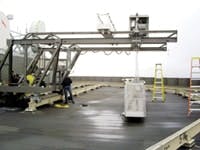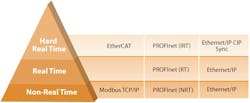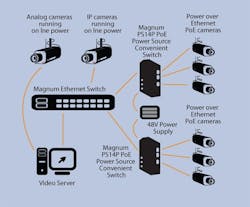New technologies require early adopters to carry them forward. It’s not enough that a new network technology is created and brought to market. What matters is when that technology brings a better solution to specific applications and then begins to see broader use. In 2008, a few things finally rose up and broke through the walls of acceptance.
Ethernet and wireless are not new, but the ways they’re being used are. From power over Ethernet (PoE) and the convergence between manufacturing and IT to interoperability and the protocols and standards that give it shape, some innovations have been around for a while but finally made their marks in 2008.
One undeniable trend in today’s manufacturing enterprise is the convergence between traditional information technology systems and manufacturing operations, giving users the opportunity to reduce risks and costs, provide secure access to information and improve agility and overall business performance, explains Brian Oulton, director, networks business, Rockwell Automation. “We worked with Cisco to develop reference architectures and documentation that provide comprehensive, detailed design guidelines for deploying Ethernet in manufacturing areas and connecting it to the enterprise. By using technology and manufacturing standards common between IT and manufacturing, these resources address the cultural and technical challenges of Ethernet network convergence between IT and engineering disciplines.”
Ultimately, manufacturing network convergence can help to align technology with business goals and create the right organization to take advantage of this alignment. “Based on feedback from customers, we’ve noticed that companies progressing toward convergence of their IT and controls-engineering organizations are reaping major benefits,” says Oulton. “These include higher efficiency, increased reliability, shorter project timelines and better business continuity. While there’s no universal solution for manufacturing-IT convergence, manufacturers have been sharing real-time data across the enterprise and value chain, as well as having real-time inventory visibility across the supply chain. By cross-pollinating between IT and controls teams, manufacturers move people between groups through formal and informal cross-training programs.
Manufacturers also have experienced success by co-developing architectures and standards, as well as defining clear ownership of equipment, access rights, decision parameters and other procedures.”
Because of Ethernet’s increasing role in modern manufacturing systems, plant-network engineers can relate more readily to similar IT concerns, too. “Engineers are faced with a new challenge previously reserved for their comrades in IT—network management,” says Phil Fricks, manager, industrial products and services, Hirschmann. “While many excellent network management tools exist, options that fit into an engineers’ toolbox are relatively limited. One solution that addresses this need are industrial profiles. The concept is straightforward—provide read/write access to network information and make it available directly to the control system. These tags are then available for use in the same manner as an I/O chassis, drive or other device. Integrating this data in an HMI/SCADA system for alarms, diagnostics or troubleshooting then becomes very simple.”
Technological innovations such as industrial managed switches address the widespread network convergence trend in manufacturing and IT organizations, adds Oulton. “A noteworthy innovation that promises to change wireless Ethernet is the recent breakthrough of the wireless-n standard, IEEE 802.11n, which is expected to meet many needs in industrial automation using standard, unmodified wireless Ethernet,” he says. “IEEE 802.11n makes wireless faster and better able to process data, thus making it more attractive for high-speed discrete applications. Wireless-n promises to change wireless Ethernet in the same way that full-duplex, 100-Bps changed wired Ethernet, making I/O control mainstream with wireless.”
Where IT and manufacturing really come together is at the diagnostic or troubleshooting stage, especially when the Internet, which falls under IT’s domain, is involved.
“Comprehensive tools in Profinet have established Ethernet as a viable, comprehensive network solution,” says Jeremy Bryant, networking business manager, AMD, Siemens Energy & Automation. “The fact is, Ethernet communications are built into PLCs and other devices, which sets the stage for benefits beyond connectivity. It’s now a simple matter to add Web browsers as standard PLC features. Users can perform diagnostics and troubleshoot PLC information using Internet Explorer instead of special vendor-specific software. The growing number of products and devices designed for Ethernet networks combined with the mass of installations using Ethernet control protocols is proving Ethernet to be the automation network of today and the future. This past year saw manufacturers actually implement many of the technological innovations, such as comprehensive control protocols, released over recent years.”
The Promise of Interoperability and Distributed I/OPlug-and-play network components have become the expected norm, says Tom Burke, president and executive director at OPC Foundation. “I have regular dialogues with vendors and plant engineers through our OPC training events that we do all over North America and Europe,” he explains. “In the overall economic climate, the emphasis on ease of configuration and maintenance of control systems and their corresponding networks has increased significantly. The emphasis on trusting the control-system information in order to streamline the efficiency of the plant operation is more and more critical as personnel resources decrease. Plant engineers are depending on vendors to make sure the system works and exceeds their expectations long before they need an operating system patch or a vendor product update.”
John Riess, marketing manager, distributed I/O, Rockwell Automation, sees two trends developing. “Along with a general increase in the use of distributed I/O, we see a greater acceptance of distributed intelligence,” he says. “That means smaller, modular controllers or additional embedded intelligence in the I/O are working in a highly distributed approach.”
The other key trend is the adoption of ring vs. traditional star topologies, says Riess. “People are more comfortable using distributed I/O with the linear and ring architecture because they help increase the flexibility, reliability and availability of the system without incurring a performance penalty,” he explains.
A Sense of WirelessEnergy for wireless-sensor applications still is a top concern for plant engineers. “We observed an interesting trend during the first quarter of 2008, namely an increase in the number of approaches to deploying wireless sensor networks for applications lacking a ready, convenient or affordable access to main power,” explains Kirsten West, principal analyst at West Technology Research Solutions, Mountain View, Calif. “It’s clear that there’s demand for solutions that manage the energy consumed by a wireless sensor network. As the wireless-sensor-network market matures, it’s inevitable that demand for low-power management will increase significantly.”
One innovative plant engineer in a highly automated factory-floor assembly and inspection cell overcame the challenge of damaged signal and network cables on highly repetitive motion applications, says Egon Hillerman, product manager—automation, low voltage products, automation products division, at ABB. He eliminated the cables and used wireless communication directly to the sensors and actuators by installing wireless interface for sensors and actuator (WISA) pads, ABB’s wireless factory-automation technology in the 2.4 GHz band, explains Hillerman. “Through the choice of frequency band, it’s ensured that communication takes place outside of the typical interference spectrum found in industrial environments,” he says. “In this respect, there are many mechanisms for ensuring interference-free, reliable operation that run automatically without the plant operator being involved. The I/O module and up to 13 wireless pads allocated to it frequency-hop continuously according to a specified pattern. In this way, they exploit the whole 2.4 GHz band. This technique avoids electromagnetic interference of signals from other communication systems that can lead to erroneous functions.”
The willingness of network engineers to embrace wireless Ethernet in 2008 stands out, especially to Bruce Hofmann, director of marketing at Weidmüller North America. “Wireless Ethernet is not a recent innovation,” he explains. “However, the willingness to deploy or, at a minimum, test wireless in a control system increased sharply over the past year.”
On a large building, cable for a window-washing stage must be as long as the building is high and tends to break often. A radio in the stage lets operators communicate wirelessly with the controller on the roof of this 50-story building.
Source: WEIDMÜLLER
Hofmann sees this as a result of two key factors. “Today, there are wireless Ethernet routers, bridges, access points and clients that function on several frequencies, both licensed and unlicensed,” says Hofmann. “These devices are available in numerous form factors including DIN-rail mountable, explosion-proof or direct machine-mount. The second factor is the increased reliability of these devices. Vendors who cater to the industrial and process markets have developed products to meet the demands of these markets, demands such as increased transmit power, wider operating temperature ratings, the ability to combine serial or I/O data and the addition of multi-level security or encryption options.”
Obtaining data from PLCs, SCADA, HMI and I/O in difficult-to-reach locations that extend beyond the reach of copper and fiberoptic cable can be a challenge, if not for wireless communication. “From operating snow-making machines across mountain ranges to communicating with window-washing equipment on high-rise office buildings, we’ve just started to realize the benefits from applying this very adaptable technology,” says Hofmann (Figure 1).
Protocol and Standard BearersThe need for IT and manufacturing to work together has a long and difficult history, but dramatic technology changes impacting industrial networks have started to reach broad adoption in the marketplace, says Robert Jackson, senior marketing manager of industrial measurements and control, National Instruments. “The release and deployment of deterministic Ethernet-based protocols for high-speed motion control really answered any doubt that industrial networking hardware will move toward Ethernet,” he says. “The availability of EtherCat, Profinet IRT, and EtherNet/IP with CIP Sync means a plant network engineer can reuse the Ethernet hardware layer from the corporate IT layer all the way to the distributed motion layer.”
When evaluating Ethernet-based protocols there are really three levels of real-time performance, explains Jackson. Non-real-time uses standard TCP/IP or UDP/IP and is intended for PLC to HMI or SCADA communications. Real-time provides added determinism, while reusing COTS hardware, and is designed for the transfer of control data. Hard real-time adds specific hardware to deliver determinism and is designed for motion control applications (Figure 2).
Various protocols enable reuse of the Ethernet hardware layer.
Source: National Instruments
“The addition of CIP Sync to EtherNet/IP allows for high-speed motion control using IEEE 1588 technology along with CIP Motion, the common industrial protocol for high-speed multi-axis motion control,” explains Jackson. “CIP Sync uses IEEE 1588 technology to distribute clocks and synchronize timebases. The level of determinism available with CIP Sync networks depends on the availability of an IEEE 1588 clock on Ethernet switches in the network and the implementation of the CIP Sync protocol on distributed devices.” System determinism is highly dependent on system design and Ethernet throughput, he says.
“EtherCat is a high-performance, industrial communication protocol for hard real-time deterministic Ethernet,” adds Jackson. “It extends the IEEE 802.3 Ethernet standard to transfer data with predictable timing and precise synchronization. This open standard is published as part of the IEC 61158 and is commonly used in applications such as machine design and motion control. EtherCat implements a master/slave architecture over standard Ethernet cabling.”
Wireless: the Talk of the TownSome of the concerns about wireless network communications are beginning to evaporate. Emerson’s Smart Wireless network, for example, is based on self-organizing technology, says Joseph Citrano, wireless program manager, asset optimization, Emerson Process Management, which virtually eliminates obstacles. Each Smart Wireless device can act as a router for other nearby devices, passing messages along until they reach the gateway. If there’s an obstruction, transmissions are rerouted until a path to the Smart Wireless Gateway is found (Figure 3). “As conditions change or new obstacles, such as temporary scaffolding, new equipment or a parked construction trailer, are encountered, these wireless networks simply reorganize and find a way to get the communication through,” he says.
Self-organizing wireless networks allow transmitters to double as routers.
Source: EMERSON PROCESS MANAGEMENT
“Because a Smart Wireless network is based on the WirelessHART standard, devices are configured and commissioned with the same tools used for wired HART devices,” explains Citrano. “The key difference between wired and wireless commissioning is that WirelessHART devices require the entry of a join key and network ID. These parameters are entered either with a HART 7-compliant HART communicator like the 375 Field Communicator or with a HART 7-compliant asset management software.”
The ongoing attempt at convergence of the WirelessHART and ISA100 standards is center stage as the wireless landscape continues to unfold.
“WirelessHART communication is the first open wireless communication standard specifically designed for process measurement and control applications,” says Ed Ladd, director of technology programs, HART Communication Foundation.
WirelessHART technology provides the opportunity to add new measurement and control points that will allow users to deploy new technology on their own terms, keeping yesterday’s control system connected to tomorrow’s devices. The HART Communication protocol has gained universal acceptance in the process industry. Adding wireless capability to the HART protocol creates a wireless process environment that is easy to deploy and fully backward-compatible.”
The ISA100 standards committee on wireless systems for automation created a new subcommittee over the summer to address options for convergence of the ISA100.11a and WirelessHART standards. The subcommittee will contrast and compare the technology within the ISA100.11a and WirelessHART standards, building on the experiences gained with industrial applications of both standards, with an ultimate goal of merging the best of both standards into a single converged subsequent release of the ISA standard.
“Wireless technology for industrial automation is clearly the most exciting thing to hit the market since the microprocessor,” says Wayne Manges, who is the ISA100 committee chair and the director of the Department of Energy’s Industrial Wireless Program for University of Tennessee-Battelle at the Oak Ridge National Laboratory in Oak Ridge, Tenn. “The potential for replacing 4-20 mA as the go-to standard for sensor interfaces is especially tempting to think about. This year marks the end of the question of whether wireless technology will become a major part of the landscape. Most of the naysayers have been silenced through numerous installations and success stories.”
The Telltale Vision
The standard for power over Ethernet (PoE) helped to power devices like IP phones, but PoE Plus promises to enable a throng of new devices and components.
Ned Lecky, owner of Lecky Integration in Little Falls, N.Y., sees a variety of vision applications that are now possible. “Gigabit Ethernet represents the confluence of so many things for industrial control,” says Lecky. “First, since it is based on standard TCP/IP and UDP/IP technology, software applications are easy to write and deploy. Hubs, network interface cards, cabling and connectors are readily available, low-cost and extremely reliable. Furthermore, at 1,000 Mbps, the speed is fast enough to contemplate moving uncompressed video across the links, as virtually all major industrial camera vendors are now doing. Finally, given the GigE Vision standards from the AIA, software compatibility between camera vendors is highly enhanced.”
For the first time, video images from multiple cameras can be routed to multiple computers, says Lecky. “This feature permits redundancy in both the imager and image analysis hardware, opening up avenues for more reliable vision-based control systems,” he says. “Furthermore, extremely high-speed applications can now easily take advantage of multiple high-speed PCs using round-robin distribution of alternating images from a single high-speed camera to two or more PCs performing image analysis. This puts military-grade architecture and reliability in the hands of the everyday OEM, at a tiny fraction of the cost.”
PoE Security Camera Network
Vision and the means to power it broke through in 2008.
GarrettCom
National Instruments
Integrating all sensor and actuator traffic on a redundant Ethernet network is now possible and allows OEMs to utilize network design skills from the IT department in helping to move data and control information around the machine without making difficult and expensive custom interconnection cables, says Lecky. “We can now build a machine frame, wire it for Ethernet the way we used to do with houses and then attach all of the sensors and actuators as necessary afterward, only routing power cables as necessary to each attached device,” he explains. “Of course, the wired network could be replaced with a wireless backbone, although in many situations this would represent a decrease in reliability and throughput at higher expense, which isn’t a good trade-off.”
In 2008, physical and cybersecurity have been on the priority list for industrial plant managers throughout the world, says Jim Krachenfels, marketing programs manager, GarrettCom. “IP video arrived, enabling the same industrial Ethernet networking infrastructure that works for control systems to be used for digital IP cameras and plant security,” he says. “And new hardened routers provide cybersecure remote access to industrial facilities.”
PoE technology has made physical security more feasible, and security devices used for access control and surveillance now are being deployed. “They are easily and economically installed since the data and power cabling is the same,” says Krachenfels. “PoE is emerging for use in SCADA applications also, with PoE industrial sensors and control devices becoming available. High-bandwidth industrial-grade Ethernet switches with IGMP and IGMP-L2 technologies and gigabit backbones now support multiple streaming video devices on a single data cable. New Ethernet reliability technologies have emerged to minimize network downtime. Plant engineers now have advanced network security and reliability technologies available.”
About the Author
Mike Bacidore
Editor in Chief
Mike Bacidore is chief editor of Control Design and has been an integral part of the Endeavor Business Media editorial team since 2007. Previously, he was editorial director at Hughes Communications and a portfolio manager of the human resources and labor law areas at Wolters Kluwer. Bacidore holds a BA from the University of Illinois and an MBA from Lake Forest Graduate School of Management. He is an award-winning columnist, earning multiple regional and national awards from the American Society of Business Publication Editors. He may be reached at [email protected]

Leaders relevant to this article:







